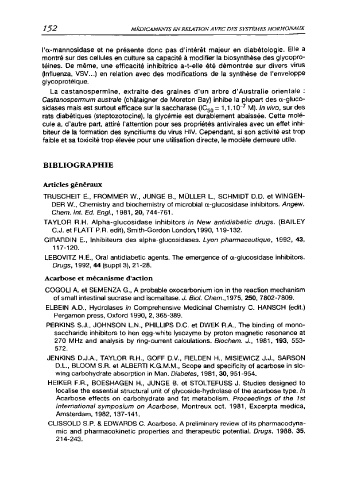Page 191 - Traité de Chimie Thérapeutique 4 Médicaments en relation avec des systèmes hormonaux
P. 191
152 MÉDICAMENTS EN RELA DON A VEC DES SYSTÈMES HORMONA UX
l'a-mannosidase et ne présente donc pas d'intérêt majeur en diabétologie. Elle a
montré sur des cellules en culture sa capacité à modifier la biosynthèse des glycopro
téines. De même, une efficacité inhibitrice a-t-elle été démontrée sur divers virus
(Influenza, VSV...) en relation avec des modifications de la synthèse de l’enveloppe
glycoprotéique.
La castanospermine, extraite des graines d’un arbre d'Australie orientale :
Castanospermum australe (châtaigner de Moreton Bay) inhibe la plupart des a-gluco-
*
sidases mais est surtout efficace sur la saccharase (IC50 = 1,1,10 7 M). In vivo, sur des
rats diabétiques (steptozotocine), la glycémie est durablement abaissée. Cette molé
cule a, d'autre part, attiré l'attention pour ses propriétés antivirales avec un effet inhi
biteur de la formation des syncitiums du virus HIV. Cependant, si son activité est trop
faible et sa toxicité trop élevée pour une utilisation directe, le modèle demeure utile.
BIBLIOGRAPHIE
Articles généraux
TRUSCHEIT E„ FROMMER W., JUNGE B., MÜLLER L., SCHMIDT D.D. et WINGEN-
DER W., Chemistry and biochemistry of microbial a-glucosidase inhibitors. Angew.
Chem. Int. Ed. Engl., 1981, 20, 744-761.
TAYLOR R.H. Alpha-glucosidase inhibitors in New antidiabetic drugs. (BAILEY
C.J. et FLATT P.R. edit), Smith-Gordon London,1990, 119-132.
GIRARDIN E., Inhibiteurs des alpha-glucosidases. Lyon pharmaceutique, 1992, 43,
117-120.
LEBOVITZ H.E., Oral antidiabetic agents. The emergence of a-glucosidase inhibitors.
Drugs, 1992, 44 (suppl 3), 21-28.
Acarbose et mécanisme d'action
COGOLI A. et SEMENZA G., A probable oxocarbonium ion in the reaction mechanism
of small intestinal sucrase and isomaltase. J. Biol. Chem.,1975, 250, 7802-7809.
ELBEIN A.D., Hydrolases in Comprehensive Médicinal Chemistry C. HANSCH (edit.)
Pergamon press, Oxford 1990, 2, 365-389.
PERKINS S.J., JOHNSON L.N., PHILLIPS D.C. et DWEK R.A., The binding of mono-
saccharide inhibitors to hen egg-white lysozyme by proton magnetic résonance at
270 MHz and analysis by ring-current calculations. Biochem. J., 1981, 193, 553
572.
JENKINS D.J.A., TAYLOR R.H., GOFF D.V., FIELDEN H., MISIEWICZ J.J., SARSON
D.L., BLOOM S.R. et ALBERTI K.G.M.M., Scope and specificity of acarbose in slo-
wing carbohydrate absorption in Man. Diabètes, 1981,30, 951-954.
HEIKER F.R., BOESHAGEN H., JUNGE B. et STOLTEFUSS J. Studies designed to
localise the essential structural unit of glycoside-hydrolase of the acarbose type. In
Acarbose effects on carbohydrate and fat metabolism. Proceedings of the Ist
International symposium on Acarbose, Montreux oct. 1981, Excerpta medica,
Amsterdam, 1982, 137-141.
CLISSOLD S.P. & EDWARDS C. Acarbose. A preliminary review of its pharmacodyna
mie and pharmacokinetic properties and therapeutic potential. Drugs, 1988, 35,
214-243.

